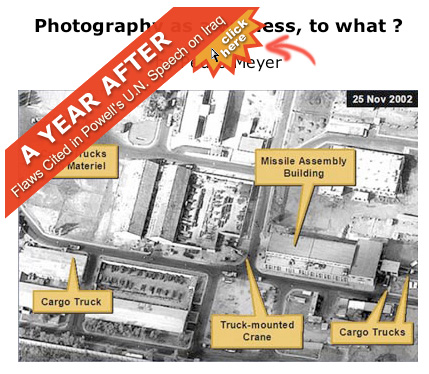 |
This
slide released 05 February 2003 by the US State Department shows several
cargo trucks participating in alleged pre-inspection removal of materials
at the Ibn al Haytham missile facility in Iraq. |
 |
This
slide released 05 February 2003 by the US State Department shows several
cargo trucks participating in alleged pre-inspection removal of materials
at the Ibn al Haytham missile facility in Iraq. |
|
|
The long standing debates about photography being a reliable source of specific information, was laid to rest this past week, when Hans Blix, the Chief Weapons Inspector in Iraq, working for the United Nations, reported to the Security Council, with regard to the "evidence" that the United States Secretary of State, Colin Powell, had introduced a few days earlier. The presentation of intelligence information by the U.S. Secretary of State suggested that Iraq had prepared for inspections by cleaning up sites and removing evidence of proscribed weapons program. "I would like to comment only on one case, which we are familiar with, said Hans Blix, namely, the trucks identified by analysts as being for chemical decontamination at a munitions depot." "This was a declared site, and it was certainly one of the sites Iraq would have expected us to inspect. We have noted that the two satellite images of the site were taken several weeks apart. The reported movement of munitions at the site could just as easily have been a routine activity as a movement of proscribed munitions in anticipation of imminent inspection. Our reservation on this point does not detract from our appreciation for the briefing."
The issue I want to bring up, is that the subjective interpretation by either Colin Powell or Hans Blix, leaves photography as a reference, well, as it should be, as an instrument with which we can have multiple interpretations about it's content. In the digital era, much has been said about the manipulation of images and how that would cause photography to loose it's merit as a reliable source of documentation. Not enough has been discussed about the medium of photography as such, and how, as a matter of fact, it is unable to cope with such a responsibility. It has nothing to do with being digital or otherwise, it is that the medium is not a reliable witness to specific evidence beyond that which we subjectively wish it to be. Precisely because photography has been heralded, time and time again, as such a reliable witness, it's been rolled out repeatedly over the decades, as a tool for manipulating information. I believe it is time, we understand that photographs have to be severely questioned in relation to what we are being told that they represent. Until Hans Blix questioned the validity of the conclusions derived from the images presented by Powell, the media in general, assumed that the satellite pictures were sufficient evidence to what the Secretary of State had stated in his testimony before the Security Council in the United Nations. It is time to conclude, that a photograph can not be a witness to itself. We require additional cross references to confirm if what we are being told by way of captions, is in fact correct. Photography is a wonderful tool for expressing our ideas, including stories made by photojournalists, but be clear, the pictures we get to see represent the point of view of the photographer beyond a factual reality. In addition, the reader gives his own interpretation according to his own reasons and these do not necesarilly have to do with the facts. Pedro
Meyer click on the image to enlarge
Please share your comments on this issue with us in our forums. |